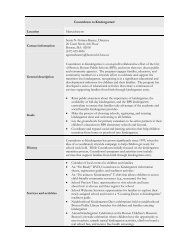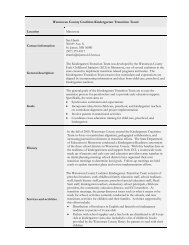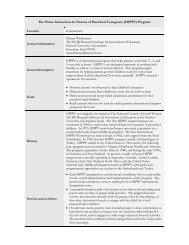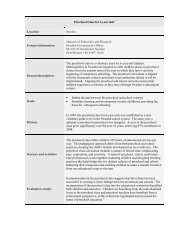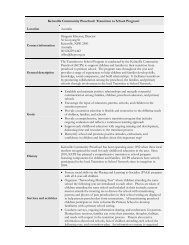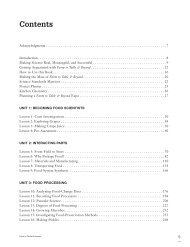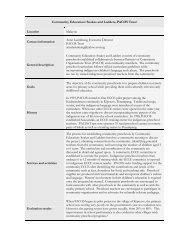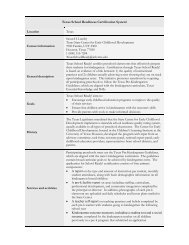Proceedings of the Fourth Annual Teachers College Educational ...
Proceedings of the Fourth Annual Teachers College Educational ...
Proceedings of the Fourth Annual Teachers College Educational ...
You also want an ePaper? Increase the reach of your titles
YUMPU automatically turns print PDFs into web optimized ePapers that Google loves.
Promoting Healthy Eating Habits Through Monster Appetite<br />
Maria Hwang, Pantiphar Chantes, Grant Tedaldi, Ann Louie R. Lomboy,<br />
<strong>Teachers</strong> <strong>College</strong>, Columbia University, 525 W. 120 th street, New York, NY<br />
Email: mlh2169@columbia.edu, pdc2114@columbia.edu, grt2106@columbia.edu,<br />
all2110@columbia.edu<br />
Abstract: The obesity epidemic is one <strong>of</strong> America’s largest public health challenges, one<br />
that creates disparities among race, ethnicity, region and income (Communities Putting<br />
Prevention to Work; Fund for Public Health in NY). Currently <strong>the</strong>re are over 12 million<br />
obese American children and adolescents (Trust for America’s Health, 2010). Intrigued<br />
by <strong>the</strong> increase in childhood obesity, Monster Appetite is a game that potentially<br />
remediates some aspects <strong>of</strong> <strong>the</strong> concern by promoting awareness <strong>of</strong> <strong>the</strong> content <strong>of</strong> food<br />
consumed by children. Through play, children learn about caloric amount in various food<br />
items that a child may select and intake daily. Through constant decision making and<br />
competitive game play, <strong>the</strong> hope is that children will start thinking more about <strong>the</strong>ir food<br />
choices and be able to make better decisions. By improving this knowledge through<br />
applied practice, children may become more cognizant about <strong>the</strong>ir food choices and<br />
capable <strong>of</strong> building healthier eating and exercise habits.<br />
Monster Appetite’s goal in promoting awareness is unique in such that players actually have to select<br />
meals <strong>the</strong>y feel contain <strong>the</strong> most calories so that <strong>the</strong>ir monster avatar can grow to <strong>the</strong> next level through<br />
<strong>the</strong> highest caloric intake. Unlike most games that promote nutritional awareness by focusing on what is<br />
best based on nutritional values, Monster Appetite employs reverse psychology and humor, where<br />
players can eventually learn about food calories but by selecting what <strong>the</strong>y feel is <strong>the</strong> highest caloric<br />
meal. By playing <strong>the</strong> game multiple times, players will eventually have a greater knowledge <strong>of</strong> which food<br />
items contain <strong>the</strong> least to <strong>the</strong> most calories as it becomes advantageous for <strong>the</strong>ir game play.<br />
In designing Monster Appetite (see Figure 1), <strong>the</strong> most critical aspect considered was <strong>the</strong> player’s overall<br />
game experience and how <strong>the</strong> rules and mechanical aspects <strong>of</strong> <strong>the</strong> game affected it. Designing a game<br />
that lessened cognitive overload during game play was an important factor that was taken into<br />
consideration. In order to expose players to as many different foods as possible, <strong>the</strong> game involves<br />
players selecting three meals a day in a span <strong>of</strong> seven days per round. The food items have been<br />
selected based on what school aged children are most likely to select to eat, where multiple grocery<br />
choices can have large variation on calories and have <strong>the</strong> high risk <strong>of</strong> causing obesity (Zinczenko &<br />
Goulding, 2008). The mechanic <strong>of</strong> selecting a meal is a fast action activity where each player rapidly<br />
selects <strong>the</strong> meal card based on seeing a picture <strong>of</strong> an item. The learning <strong>of</strong> <strong>the</strong> food items’ calories, end<br />
<strong>of</strong> day caloric calculations and execution <strong>of</strong> <strong>the</strong> actions from <strong>the</strong> game tokens are done at <strong>the</strong> end <strong>of</strong> each<br />
day as opposed to in between meals. Game tokens can impact <strong>the</strong> player negatively or positively: for<br />
example, doing yoga causes a player to lose calories, but a bonus meal card gives a player additional<br />
calories for <strong>the</strong> total daily intake, which will help <strong>the</strong> player’s monster grow more rapidly. These effects <strong>of</strong><br />
<strong>the</strong> tokens are based <strong>of</strong>f real research <strong>of</strong> exercise and behavioral habits (Costikyan, 2006).<br />
By implementing rules, supported by <strong>the</strong> use <strong>of</strong> simple game pieces such as <strong>the</strong> tokens, dice, calculators<br />
and game actions involving fast hand and eye coordination movements, Monster Appetite creates a fun<br />
way <strong>of</strong> learning nutritional awareness. The design creates an environment for players where <strong>the</strong> game<br />
play does not produce cognitive overload, but allows players to have fun through fast-pace, easy-to-follow<br />
rules and means <strong>of</strong> learning about foods <strong>the</strong>y recognize, and are likely to consume.<br />
Figures and Tables<br />
24



